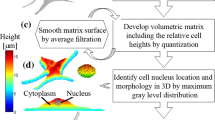Abstract
As a prelude to the understanding of mechanotransduction in human embryonic stem cell (hESC) differentiation, the mechanical behavior of hESCs in the form of cell pellet is studied. The pellets were tested after 3 or 5 weeks of cell culture in order to demonstrate the effect of the duration of cell culture on the mechanical properties of the pellets. A micromechanical tester was used to conduct unconfined compression on hESC pellet, and experimental, numerical, and analytical methods were combined to determine the mechanical properties of hESC pellet. It is assumed that the mechanical behavior of hESC pellets can be described by an isotropic, linear viscoelastic model consisting of a spring and two Maxwell units in parallel, and the Poisson’s ratio of the hESC pellet is constant based on pellet deformation in the direction perpendicular to the compression direction. Finite element method (FEM) simulation was adopted to determine the values of Poisson’s ratio and the five parameters contained in the viscoelastic model. The variations of Poisson’s ratio and the initial elastic modulus are found to be larger compared with those of the four other parameters. Results show that longer duration of cell culture leads to higher modulus of hESC pellet. The effect of pellet size error on the values of mechanical parameters determined is studied using FEM simulation, and it is found that the effect of size error on Poisson’s ratio and initial elastic modulus is much larger than that on the other parameters.
Similar content being viewed by others
References
Alexopoulos LG, Williams GM, Upton ML, Setton LA, Guilak F (2005) Osteoarthritic changes in the biphasic mechanical properties of the chondrocyte pericellular matrix in articular cartilage. J Biomech 38(3): 509–517
Bates JHT (1998) A micromechanical model of lung tissue rheology. Ann Biomed Eng 26(4): 679–687
Buschmann MD, Gluzband YA, Grodzinsky AJ, Hunziker EB (1995) Mechanical compression modulates matrix biosynthesis in chondrocyte/agarose culture. J Cell Sci 108(4): 1497–1508
Caille N, Thoumine O, Tardy Y, Meister J-J (2002) Contribution of the nucleus to the mechanical properties of endothelial cells. J Biomech 35(2): 177–187
Cheng L, Hammond H, Ye Z, Zhan X, Dravid G (2003) Human adult marrow cells support prolonged expansion of human embryonic stem cells in culture. Stem Cells 21(2): 131–142
Christensen RM (1982) Theory of viscoelasticity: an introduction, 2nd edn. Academic Press, New York
Elder SH, Goldstein SA, Kimura JH, Soslowsky LJ, Spengler DM (2001) Chondrocyte differentiation is modulated by frequency and duration of cyclic compressive loading. Ann Biomed Eng 29(6): 476–482
Guilak F (1995) Compression-induced changes in the shape and volume of the chondrocyte nucleus. J Biomech 28(12): 1529–1541
Guilak F, Mow VC (2000) The mechanical environment of the chondrocyte: a biphasic finite element model of cell-matrix interactions in articular cartilage. J Biomech 33(12): 1663–1673
Huyghe JM, van Campen DH, Arts T, Heethaar RM (1991) The constitutive behavior of passive heart muscle tissue: a quasi-linear viscoelastic formulation. J Biomech 24(9): 841–849
Jones WR, Ting-Beall HP, Lee GM, Kelley SS, Hochmuth RM, Guilak F (1999) Alterations in the Young’s modulus and volumetric properties of chondrocytes isolated from normal and osteoarthritic human cartilage. J Biomech 32(2): 119–127
Myers BS, McElhaney JH, Doherty BJ (1991) The viscoelastic responses of the human cervical spine in torsion: Experimental limitations of quasi-linear theory, and a method for reducing these effects. J Biomech 24(9): 811–817
Nasseri S, Bilston LE, Phan-Thien N (2002) Viscoelastic properties of pig kidney in shear, experimental results and modelling. Rheol Acta 41(1–2): 180–192
Ofek G, Willard VP, Koay EJ, Hu JC, Lin P, Athanasiou KA (2009) Mechanical characterization of differentiated human embryonic stem cells. J Biomech Eng 131(6): 061011
Phan-Thien N, Nasseri S, Bilston LE (2000) Oscillatory squeezing flow of a biological material. Rheol Acta 39(4): 409–417
Pinto JG, Fung YC (1973) Mechanical properties of heart muscle in passive state. J Biomech 6(6): 597–616
Reubinoff BE, Pera MF, Fong C-Y, Trounson A, Bongso A (2000) Embryonic stem cell lines from human blastocysts: somatic differentiation in vitro. Nat Biotechnol 18(4): 399–404
Saha S, Ji L, de Pablo JJ, Palecek SP (2008) TGF beta/Activin/Nodal pathway in inhibition of human embryonic stem cell differentiation by mechanical strain. Biophys J 94(10): 4123–4133
Sanjeevi R (1982) A viscoelastic model for the mechanical properties of biological materials. J Biomech 15(2): 107–109
Sato M, Theret DP, Wheeler LT, Ohshima N, Nerem RM (1990) Application of the micropipette technique to the measurement of cultured porcine aortic endothelial cell viscoelastic properties. J Biomech Eng Trans ASME 112(3): 263–268
Tan SCW, Pan WX, Ma G, Cai N, Leong KW, Liao K (2008) Viscoelastic behaviour of human mesenchymal stem cells. BMC Cell Biol 9: 40
Terraciano V, Hwang N, Moroni L, Park HB, Zhang Z, Mizrahi J, Seliktar D, Elisseeff J (2007) Differential response of adult and embryonic mesenchymal progenitor cells to mechanical compression in hydrogels. Stem Cells 25(11): 2730–2738
Thomson JA, Itskovitz-Eldor J, Shapiro SS, Waknitz MA, Swiergiel JJ, Marshall VS, Jones JM (1998) Embryonic stem cell lines derived from human blastocysts. Science 282(5391): 1145–1147
Trickey WR, Baaijens FPT, Laursen TA, Alexopoulos LG, Guilak F (2006) Determination of the Poisson’s ratio of the cell: recovery properties of chondrocytes after release from complete micropipette aspiration. J Biomech 39(1): 78–87
Wu JZ, Herzog W (2006) Analysis of the mechanical behavior of chondrocytes in unconfined compression tests for cyclic loading. J Biomech 39(4): 603–616
Author information
Authors and Affiliations
Corresponding author
Rights and permissions
About this article
Cite this article
Ma, G., Petersen, E., Leong, K.W. et al. Mechanical behavior of human embryonic stem cell pellet under unconfined compression. Biomech Model Mechanobiol 11, 703–714 (2012). https://doi.org/10.1007/s10237-011-0344-9
Received:
Accepted:
Published:
Issue Date:
DOI: https://doi.org/10.1007/s10237-011-0344-9




